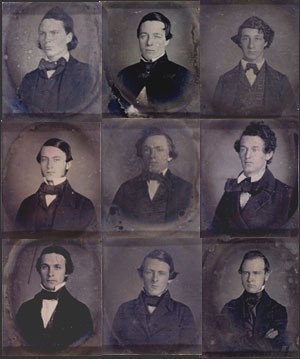
From left to right, top to bottom, Portraits
of Abram Hoogland LaMonte, Charles Russell Clarke, John Craig Schenck,
William Erskine Skinner, Silas Merchant, Jr., Alfred Eli Lewis, Charles
Thomas Haley, Patrick Henry Rutledge, and Samuel Alexander McElhinney,
all members of the Class of 1853. 1852-1853. Sixth plate daguerreotypes.
Photographer unknown. [After Treatment]
|
With the electro-cleaning treatment these nine Princeton students
emerged from the haze of corrosion behind which they were hidden for
over a century. While the images do not appear as pristine as they
did in 1853, the faces of these men are now clear and distinctive.
The students had these portraits made to hang in the College Portrait
Gallery in Nassau Hall. James Buchanan Henry and Christian Henry Scharff
noted this tradition in a guide they wrote for their fellow students,
College As It Is. Or, The Collegian's Manual in 1853.
"It has been customary for the Senior Class, since the year 1850,
to have their Daguerreotypes taken for the College Picture Gallery.
We think this a very pretty and interesting custom for an alumnus returning
on a visit to Princeton years after graduation, has the satisfaction
of once more seeing the familiar faces of all his classmates, and of
perhaps showing to his pretty wife how he himself used to look when
a collegian. The Class sends on to Phila or New York about the month
of April, to secure the services of some good artist (Richards of Phila,
last class)."
Once the individual portraits were taken, they were placed together
in a frame and hung on the wall, or they were redaguerreotyped to
create a smaller composite
version. As Henry and Scharff note, Frederick DeBourg Richards
from Philadelphia took the daguerreotype portraits of the Class of
1852.
|